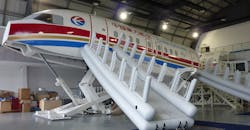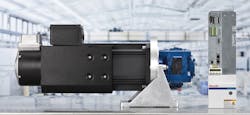Variable Speed Pump Drives Help Aircraft Simulator Mimic the Unthinkable
The Cabin Emergency Evacuation Trainer (CEET) simulator creates conditions that are as real-to-life as possible, letting aircraft cabin crews experience the psychological pressures and physical situations encountered during emergencies that include air turbulence, fire, forced landings or even a crash. Practicing emergency procedures under safe conditions ensures that the cabin crew will be prepared to cope with these situations if they ever develop.
A CEET includes an aircraft fuselage and a motion system. It can be used to simulate a range of emergency situations, for example, to train cabin crews how to deploy the escape slides under arduous conditions. The motion system provides three axes of motion (roll, pitch, and heave), while other systems simulate fire and even produce smoke and heat. The hybrid motion system replicates the highly dynamic cabin movements that can result from extreme aircraft motion. Three hydraulic actuators set the 16.5- or 33-ton fuselage section in controlled motion and accelerate it at up to 0.5 G with the highest safety standards, ensuring that the exercise does not itself turn into a bona-fide emergency.
The eCEET is outfitted with a cockpit, forward and rear entrance areas, and a cabin configured with six-seat rows. The first delivery started at Lufthansa in 1999 at Frankfurt Airport, with many in China, and the latest Sytronix eCEETs at KLM Amsterdam and ANA Airlines in Tokyo. Many airlines have introduced the CEET into their training programs for the Airbus 320/321. KLM Royal Dutch Airlines is using this system at its new training facility, which is equipped for Boeing 777 aircraft.
Integrated Drive Package
The fuselage of the eCEET also contains a real-time visual and audio system, functional inter-cabin communications, fire and smoke simulation, auto-retractable oxygen dropdown units, a functional galley space, and HD CCTV recording and playback. The simulator’s three-axis motion systems provided today are equipped with a Sytronix variable-speed pump drive system from Bosch Rexroth that mimics the extreme motions an aircraft might encounter in various emergency situations, such as turbulence, nose wheel collapse, landing on water, and many more scenarios.
This drive and control system is based on Bosch Rexroth’s Sytronix frequency-controlled pump drive. The company was the first to introduce a motion system for this purpose more than 25 years ago and has since supplied and installed 30 units worldwide. It combines two of the company’s well-established technologies to deliver the reliability of powerful hydraulics and the energy efficiency and dynamics of compact electrical drive technology. Each Sytronix system that actuates a cylinder includes a separate self-contained servo motor and pump connected directly to each cylinder.
Because each cylinder is supplied by its own Sytronix drive, which controls its direction and position, there is no need for a proportional or servovalve for each cylinder, nor a pipe network linking the three cylinders to a central hydraulic power unit (HPU). Hans ten Hagen and Jack Bergmans of Bosch Rexroth in Boxtel, Netherlands, explain, “Basically, it provides power on demand. When a motor is running, the associated pump is running, and the cylinder is moving. When the motor stops, the pump stops, and the cylinder stops.” An integrated absolute position transducer provides the actuator position as feedback for closing the control loop.
The flow rate of the system is determined by the drive speed of the electric motor and the pump displacement. During operation, the pressure-volume flow target values are sent to the control. The system pressure is measured by a pressure transducer and sent to the controller. Based on the control deviation, the built-in PID controller calculates the required motor speed and adjusts it to produce the required flow rate and pressure. When the volumetric flow to a cylinder decreases, the system pressure also drops. To compensate for the reduction in pressure, the pressure control increases the speed of the asynchronous motor via the frequency converter. This increases the delivery volume of the pump and provides the required volumetric flow.
Electrohydraulic Drive Choices
Sytronix drives offer many options for compact drive applications and also provide energy-saving benefits, noise reduction, and compact design, along with increasing the machine lifespan. They deliver flow on demand; therefore, they can control pressure, volume, position, and force, and can also limit pump power consumption.
Compared to standard systems, power consumption can be reduced up to 50% and the noise level by up to 20 dBA by reducing speed of the motor-pump based on system requirements. The Sytronix drives are available in three versions—one for machines needing a constant-pressure source, one for pressure and flow control with a power-limiting function, and one with pressure and flow control for managing force and speed.
SvP Sytronix drives use permanent-magnet) servomotors for precise position control while using substantially less energy than conventional hydraulic drives. Capabilities include axis control functions in both open and closed hydraulic circuits requiring high dynamic performance.
For constant-pressure systems, there are two Sytronix systems that differ considerably in operating principle and application. FcP is a smart solution for small-to-medium performance needs with high noise emission requirements. DRn is a powerful, dynamic, and cost-effective solution for large-drive power requirements from approximately 18.5 kW. It uses a frequency converter to detect the motor and pump conditions and adjusts the speed to precise values as required. By unloading the motor in stand-by operation, it achieves high overload capacity.
Sytronix DFEn and EPn drives are offered for applications requiring both pressure and flow control. With systems and machines in the higher performance range, pressure-flow control systems often are employed to control the motor power as required—in fast forward movements or in powerful pressing processes, for instance. In this connection, a variable-displacement pump is used instead of a gear pump. DFEn systems comprise one electrohydraulically controlled axial-piston pump with a speed-variable asynchronous motor. The EPn 7020 system combines the advantages of a variable-speed drive and variable-displacement pump and also is suitable for flow control.
Sytronix type SvP (servo-variable pump drive) 7020 drive systems consist of a motor-pump unit driven by a synchronous servo motor with permanent magnet and servo control. SvP offers the highest dynamic performance and closed-loop accuracy as well as the broadest range of functionalities, from pressure control and alternating pressure/flow control to alternating position and force control.
The command and actual values for pressure, flow, and position can be adjusted and monitored by a superior machine control using either an analog interface or an industry-standard bus interface, providing easy and flexible integration into machine control systems. These customized, compact solutions are easy to install and commission. They reduce noise in the smallest spaces and achieve higher dynamics with up to 80% energy savings.
About the Author
Ray I. Scroggins
Principal and Founder
Ray I. Scroggins is a frequent writer on subjects that include technology, manufacturing, construction and business. He holds degrees in business and engineering and specializes in writing feature articles for a wide range of business and trade publications. He is the principal of Scroggins Associates, LLC, a public relations firm he founded in 1984 and is based in Las Cruces, NM.

Leaders relevant to this article:



